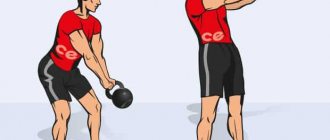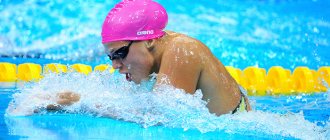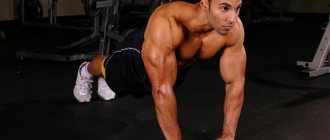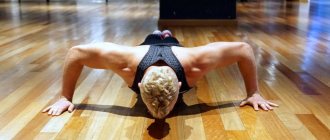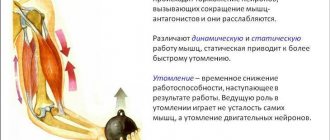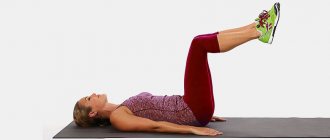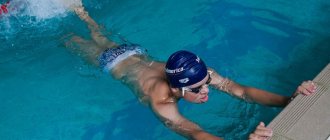Benefits of triceps push-ups
- This is an excellent basic exercise that involves almost all the muscles of the shoulder girdle.
- Allows you to work with your own weight, without special equipment and simulators. You can do it at home, doing push-ups from a chair or sofa.
- Helps stretch the fibers of the pectoral muscles, opening the chest, improving posture.
- Strengthens the ligamentous apparatus of the shoulder girdle, allowing the muscles to subsequently receive serious load when working with weights.
- Increases overall endurance.
- Helps speed up metabolism.
Performance technique
Now let's look at the correct push-up technique. Here the algorithm is as follows:
- Prepare a couple of benches and install them parallel. The distance between the benches is adjusted individually, taking into account the length of the legs.
- Turn your back to one of the benches, place your hands on the edge of the bench and throw your legs onto the parallel bench.
- Find a position that is comfortable for your body. Make sure your feet are not too far away - they should be on the edge. This is the starting position.
- As you inhale, begin to slowly lower yourself, gradually bending your arms at the elbow joint. Lower yourself to a position where your chest feels the maximum stretch (without feeling discomfort). Keep your elbows straight and do not let them spread out to the sides.
- From the bottom position, as you exhale, begin lifting using only arm strength to the starting position.
- Do the exercise the required number of times (10-12).
Reverse push-ups are not as simple as they may seem. Failure to comply with the technique leads to a lack of results or even injury.
Reverse grip push-up technique
- With your back to the bench, place your palms under your shoulder joints with your fingers facing forward.
- The body is vertical, the pelvis canopied closer to the bench.
- Straighten your knees, place your pelvis width in front of you, resting on your heels.
- As you inhale, slowly bend your elbows until your shoulder is parallel to the floor. The torso is lowered to the floor with a straight back along the bench.
- Exhale, straighten your elbows and return to the starting position on straight arms, without touching the bench with your pelvis.
Execution technique
Let's look at how to do reverse push-ups - a technique of lightweight and classic movements.
Easier movement
Suitable for beginners, girls and overweight people. Execution schemes:
- place your feet on the floor and your hands on the bench - palms down, slightly wider than your shoulders, the starting position involves almost completely straightened arms, legs can be kept either straight or slightly bent, buttocks are closer to the bench without touching it, gaze - forward, back straight,
- smoothly lower your pelvis down, at the same time bending your arms at the elbows, the arms must be kept pressed to the body, if you move them to the sides, the risk of injury increases and the load on the triceps decreases, the amplitude should be deep, but within reason - there is no need to strive to touch the buttocks floor, this is fraught with problems with the shoulder joints, if you are already experiencing minor problems with your shoulders, lower yourself to a comfortable depth,
- as you exhale, return to the starting position, no need to straighten your arms completely - leave your triceps tense and your elbows healthy,
- do the required number of repetitions.
Classical technique
Two benches of the same height, located parallel, are used. One serves as a rest for the arms, the other for the legs. The distance between the benches depends on the length of the legs. The starting position of the hands is similar to that described above. Place your feet with your heels on the bench. The rest of the technique is the same as in the lightweight version.
Recommendations
Do reverse push-ups correctly - the execution technique depends on understanding the nuances. Some subtleties:
- recommended depth - the point at which the shoulders are parallel to the floor,
- lower yourself smoothly, controlling each segment of the trajectory of movement, rise with a more explosive movement, but observing safety precautions,
- the back moves along a vertical axis - keep your back straight at all times,
- to lift, use exclusively the triceps; assistance from the triceps buttocks or other auxiliary muscles reduces the effectiveness of the exercise,
- the more your knees are bent, the less load on the triceps,
- do not spread your elbows - this engages the lats and relieves stress on the target muscles,
- if the goal is to “finish off” the triceps with a pump, the exercise can be performed at the end of the triceps training; if the goal is to work the triceps as much as possible, it is better to do push-ups at the beginning of the workout.
Push-up program
There are a lot of training programs. Strength training involves one scheme, mass-gaining – another, relief – a third, endurance – a fourth. We offer a program that will allow you to increase the number of reverse push-ups to 100 in 7 weeks.
Of course, the plan is conditional - the starting and final parameters depend on the athlete’s level. The scheme is designed for beginners, but beginners are different. We start from the average level of training of a “junior”.
Software recommendations:
- do push-ups twice a week - after working on your back and chest,
- after chest training – 4-5 sets of push-ups with a break of 1-1.5 minutes,
- then work on the back muscles, after which 2 sets of triceps, try to push up to failure, the rest between sets is increased - to the required level of recovery,
- within the framework of the dips on bench program - the only exercise for the triceps,
- if the scheme is too easy or, conversely, too heavy, you need to reduce or add the number of repetitions,
- at the end of seven training weeks, take a break - let the muscles and ligaments rest for several days, then you can either continue working on a similar program, adding intensity, or modify the scheme for other tasks.
Reverse push-ups - program for number of repetitions:
| A week | Number of sets and repetitions |
| 1 | after chest – 5 sets of 12 times after back – 2 sets of 20 times |
| 2 | after chest – 5 sets of 15 times after back – 2 sets of 25 times |
| 3 | after chest – 4 sets of 20 times after back – 2 sets of 35 times |
| 4 | after chest – 4 sets of 30 times after back – 2 sets of 55 times |
| 5 | after chest – 5 sets of 40 times after back – 2 sets of 70 times |
| 6 | after chest – 4 sets of 55 times after back – 2 sets of 85 times |
| 7 | after chest – 4 sets of 70 times after back – 2 sets of 100 times |
Simplified options
Reverse push-ups with bent knees
For those who are starting to learn the exercise from scratch, you can perform a simplified technique with bent knees.
- The technique and placement of the palms does not change.
- And focusing on your full foot with your knees at right angles eases the load on your arms, since part of the body weight falls on your legs.
The option is performed - from 15 to 25 repetitions, 3-4 approaches.
Reverse push-ups
This option is a simplified way of doing push-ups from a bench. Due to the small range of motion, the muscles receive significantly less load. This option can also be performed on special push-up supports.
- Sitting on the floor, place your palms under your shoulders with your fingers facing forward.
- Place your feet on the floor under your knee joints, pelvic width apart.
- Raise your pelvis up and hold the canopy until the end of the approach.
- As you inhale, bend your elbows and lower your torso toward the floor, moving your shoulder and pelvis closer to your feet.
- Exhale and straighten your elbows.
The technique of reverse push-ups without weights should be performed with a large number of repetitions, as the exercise develops muscle endurance more. Bodyweight exercises are most often performed from 15 to 25 repetitions of 3-4 sets. The last repetitions should cause a burning sensation in the muscles.
Varieties of exercise
There are 3 main variations of push-ups:
- classic - arms and legs rest on benches; 2 benches are used;
- lightweight - hands on the bench, feet on the floor;
- advanced - weights are used.
There are also intermediate options. Having mastered lightweight push-ups, you can increase the load by lifting one leg. Let us remind you that the location of the arms and legs affects the intensity of the exercise. Therefore, within the framework of the main types, it is possible and necessary to experiment. But be sure to follow the technique. For example, you should not lean on the bench with your fists instead of your palms.
Modifications to make the exercise more difficult
The following options are more complex than placing your feet on the floor. The degree of load on the arms increases significantly, since the position of the feet above the floor level shifts the load of one’s own body from the legs to the arms.
Reverse push-ups with feet on bench
- Place your hands on the bench behind you under your shoulders, and place your feet on the second bench in front of you, previously set at a distance of outstretched legs.
- As you exhale, bend your elbows, lowering your pelvis toward the floor along the bench.
- When the shoulder joints are level with the elbow joints, extend your arms as you exhale.
- Repeat the movement as many times as necessary, after the last repetition, remove your feet from the bench and straighten your torso.
Reverse push-ups with weights, feet on a bench
For this option, you need an assistant who will apply the load. For weights, it is better to choose pancakes of different weights. Their shape will rest better on your hips, unlike a barbell or barbell.
- Place your palms on the bench under your shoulders, and your feet hip-width apart on the second bench.
- Have an assistant place a plate of the desired weight on your thighs above your knees.
- Bend your elbows with full range of motion, lowering your torso and pelvis as you inhale.
- Exhale and straighten your palms without touching the bench with your pelvis.
This version of the exercise can be performed from 8 to 12 repetitions in 4 sets. It can be used in a program to increase muscle mass.
Sample program for beginners and experienced athletes
Beginner athletes are recommended to do reverse bench push-ups for the triceps at the beginning of their workout. Reverse push-ups require significant energy expenditure and are unlikely to be tough at the end, after strength approaches. Pre-do exercises to warm up your back and chest.
- Do 1 set of 15 repetitions with your legs bent at the knees;
- Perform 2 more sets of 10 repetitions without bending your legs;
- Rest between approaches – no more than 2 minutes;
- Perform the complex 2 times a week, each time increasing the number of repetitions by 3;
- When you feel ready, try placing a barbell plate on your feet (secure it well).
Experienced athletes can use reverse push-ups to stretch their upper body muscles and prepare their arms for more serious work.
- They are included either in the warm-up complex or transferred to the end of the lesson to consolidate the achieved results;
- Do push-ups with both arms and legs on the bench, using weights;
- Do 4-5 sets of 15-20 repetitions;
- Perform the complex 2-3 times a week.
Remember, reverse push-ups will give better results if you combine them with exercises for other arm muscles. In this case, the muscles will grow and develop evenly, which means that a beautiful relief will be achieved much earlier. Good luck in your training!
Content
- 1 Differences between the reverse grip press and the classic one
- 2 Correct reverse grip press technique is the key to success 2.1 Subtleties of the reverse grip press
Reverse grip barbell press
Video: reverse grip barbell press (lying)
The reverse grip barbell press was invented, oddly enough, long before the incline bench press. And it was used to “explode” the upper chest. However, a detailed analysis revealed additional advantages of this exercise:
- working out the upper pectoral muscles. Usually, this is done with an incline bench press, however, the reverse press also brings decent results;
- triceps work. Moreover, he does not exclude the chest, as happens with the classic bench press, but only refines the movement. This is especially true for the final phase of the exercise, when the bar is at the top point;
- the elbow is in an isolated position, this does not allow the athlete to simply physically move their elbows apart. It is very useful after injuries to the elbow joint, when the classic bench press leads to very unpleasant painful effects.
Benefits of reverse push-ups
This exercise is so simple that not only professionals, but also beginners can perform it. Of course, with some adjustments for the level of training.
Beginners are recommended to start triceps training with this exercise. Only after achieving some progress in it, you can take up dumbbells and barbells.
This exercise helps strengthen the joints, ligaments of the hands, tone the muscles, and also strengthen the connection between the muscles and the brain. The latter will allow you to perform more complex exercises with more weight in the future. Only after performing bench push-ups from behind, when you better understand the technique and biomechanics of their implementation, can you move on to the triceps bench press and other exercises that load this muscle. This way you will reduce the risk of injury to your elbow joints or wrists.
Experienced athletes also use this exercise in their training, but with a slightly different goal - to “finish off”, to pump up the triceps with isolated work, so that each of its fascicles is beautifully drawn and stands out. To do this, they perform an exercise at the end of the workout, after which the triceps look advantageous against the background of the developed biceps and deltoids.
Back push-ups are especially useful for women, since they store more fat in the triceps area than men. Hence sagging arms, cellulite and stretch marks.
After menopause, fat usually disappears quickly on this part of women’s arms, leaving stretched, loose skin.
At the same time, women often avoid working with their hands altogether, fearing that they will outrageously increase in volume. In fact, even well-developed arm muscles are not easy for girls to achieve, and exercises with their own weight will never lead to muscle hypertrophy. Therefore, reverse-grip push-ups from a bench are primarily recommended for women.
